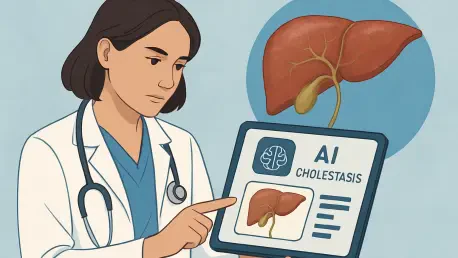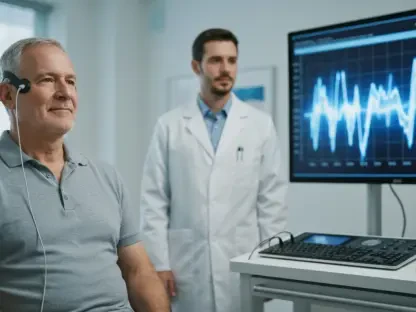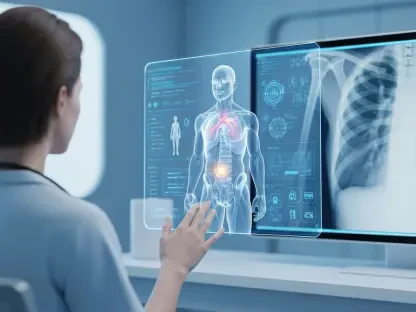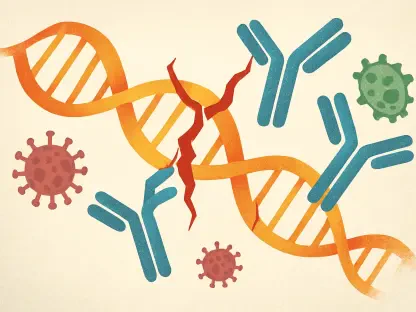Picture a scenario where a newborn’s routine liver test could instantly signal a rare genetic condition, slashing diagnostic delays and guiding medical teams toward the most effective care plan before irreversible damage sets in. This transformative possibility is becoming a reality with an innovative artificial intelligence (AI) tool named Jaundice Diagnosis Easy for Baby (JADE-B). Specifically crafted to detect genetic forms of cholestasis—a liver condition marked by blocked bile flow—in infants, this technology promises to reshape pediatric healthcare. Conditions like progressive familial intrahepatic cholestasis (PFIC) and Alagille syndrome, often hidden among more common ailments, can now be flagged for genetic testing through standard test data analysis. Developed through international collaboration, JADE-B represents a leap forward in addressing the intricate challenge of early diagnosis in vulnerable populations. This article explores how this AI model works, why it matters, and what lies ahead for its application in clinical settings across the globe.
Unraveling the Complexity of Infant Cholestasis
Cholestasis in infants emerges as a critical health issue, characterized by impaired bile flow from the liver, which can trigger severe damage if left unchecked. Symptoms such as jaundice, pale stools, and persistent itching often serve as the first clues, yet pinpointing whether the cause is genetic or non-genetic remains a daunting task for clinicians. Non-genetic conditions like biliary atresia may require urgent surgical intervention, while genetic disorders demand different management strategies. The rarity of inherited forms, coupled with overlapping clinical signs, frequently leads to prolonged diagnostic journeys involving costly and invasive tests. This delay can worsen outcomes, particularly when time-sensitive treatments are needed. The pressing demand for a streamlined approach to identify the root cause has set the stage for technological innovation, highlighting the urgent need for tools that can differentiate between these complex causes with speed and precision.
Beyond the immediate symptoms, the diagnostic challenge of cholestasis lies in its diverse origins and the limited window for effective intervention. Genetic conditions such as PFIC or Alagille syndrome are often buried beneath more prevalent non-genetic causes, making targeted testing a resource-intensive process. Traditional methods rely heavily on extensive evaluations, which may not be feasible in all healthcare settings, especially those with limited access to specialized facilities. Misdiagnosis or delayed diagnosis can lead to irreversible liver damage, underscoring the critical nature of early detection. The emotional and financial toll on families navigating this uncertainty further amplifies the problem, as they await clarity on their child’s condition. A solution that leverages widely available clinical data to prioritize high-risk cases could fundamentally alter this landscape, offering hope for faster, more accurate pathways to treatment and long-term care planning.
AI Innovation: The Power of JADE-B
A groundbreaking response to these diagnostic hurdles comes in the form of JADE-B, an AI-driven model developed through a collaborative effort by researchers from Taiwan, Thailand, and South Korea. Published in the Journal of Pediatric Gastroenterology and Nutrition, this tool harnesses machine learning to analyze data from routine liver function tests, identifying patterns suggestive of genetic cholestasis. Trained on a dataset of over 1,000 infants, with a subset confirmed to have genetic disorders, JADE-B incorporates 20 key parameters, including bilirubin levels and enzymes like alkaline phosphatase (ALP) and gamma-glutamyl transferase (GGT). Its performance is striking, achieving an 84.2% sensitivity in detecting genetic cases and an 82.4% specificity in excluding non-genetic ones. By potentially reducing unnecessary genetic testing by over 78%, this model offers a cost-effective way to focus resources on infants most likely to benefit from further investigation.
The significance of JADE-B extends beyond its technical prowess to its practical application in real-world clinical environments. Unlike traditional diagnostic approaches that often demand specialized expertise and extensive testing, this AI model relies on data already collected during standard assessments. This accessibility makes it a viable option even in under-resourced healthcare systems where advanced genetic testing may be out of reach. During validation with the initial cohort, the model demonstrated a remarkable ability to streamline the diagnostic process, ensuring that high-risk infants are prioritized for confirmatory genetic analysis. Additional testing on an external group from Thailand and South Korea, while showing slightly reduced accuracy, still confirmed its reliability across different populations. Such results suggest that with further refinement, JADE-B could become an indispensable tool for pediatric hepatologists worldwide.
The Stakes of Timely Detection
The importance of early diagnosis in cholestasis cannot be overstated, as the timing of intervention often dictates the trajectory of an infant’s health. For non-genetic conditions like biliary atresia, prompt surgical procedures can be lifesaving, preventing rapid progression to liver failure. In contrast, genetic forms, though not always amenable to immediate fixes, benefit immensely from early identification, enabling tailored management plans and informed family counseling. JADE-B serves as a vital decision-support mechanism, stepping in after urgent non-genetic causes are ruled out to highlight infants with a higher likelihood of inherited disorders. This targeted approach minimizes diagnostic delays, ensuring that limited medical resources are allocated efficiently. By bridging the gap between initial suspicion and definitive testing, the model helps safeguard long-term outcomes for some of the most vulnerable patients.
Moreover, the ripple effects of early diagnosis extend to the broader healthcare ecosystem, alleviating systemic pressures. Families grappling with the uncertainty of an infant’s condition often face significant emotional and financial burdens, compounded by lengthy waits for answers. A tool like JADE-B, by accelerating the identification of probable genetic cases, reduces the need for exhaustive testing protocols that drain both time and budgets. This efficiency is particularly crucial in regions where access to pediatric specialists or genetic testing facilities is limited, as it empowers general clinicians with actionable insights from routine data. Beyond individual patient care, widespread adoption of such technology could inform public health strategies, optimizing resource distribution and enhancing overall care standards for rare liver conditions in infancy. The potential to transform diagnostic timelines offers a beacon of hope for improved quality of life.
Future Horizons and Obstacles to Overcome
Looking forward, the promise of JADE-B is tempered by challenges that must be addressed to ensure its global impact. While initial results are encouraging, validation on an external cohort from Thailand and South Korea revealed slight dips in accuracy, pointing to variations in patient demographics and clinical practices as influencing factors. Researchers advocate for expansive multi-center studies to refine the model, ensuring it adapts to diverse genetic backgrounds and healthcare environments. Such efforts are essential before JADE-B can be integrated into standard clinical workflows. The vision extends beyond cholestasis, with aspirations to apply similar AI methodologies to other rare pediatric conditions, heralding an era of precision medicine where diagnostics are customized to individual needs. This trajectory reflects a larger trend in healthcare, blending technology with clinical insight to solve intricate medical puzzles.
Additionally, the path to widespread implementation involves navigating logistical and ethical considerations unique to AI in medicine. Ensuring data privacy and mitigating biases in the training datasets are paramount to maintaining trust in tools like JADE-B. The model’s reliance on specific liver test parameters also raises questions about its adaptability to settings where testing protocols differ. Collaborative efforts across international research bodies will be crucial to standardize its application and address these limitations. Furthermore, educating healthcare providers on the model’s role as a supportive rather than definitive diagnostic tool will prevent over-reliance and preserve clinical judgment. As these hurdles are tackled over the coming years, the potential for AI to revolutionize early detection in pediatric hepatology grows stronger, offering a glimpse into a future where technology enhances every facet of patient care with precision and efficiency.
Reflecting on a Technological Milestone
Reflecting on this advancement, the emergence of JADE-B marks a pivotal moment in the journey toward better diagnosing genetic cholestasis in infants. Its ability to analyze routine liver function data with high accuracy provides a lifeline for clinicians seeking to prioritize genetic testing for at-risk babies. The model’s success in reducing unnecessary tests by a substantial margin underscores its value in optimizing healthcare resources. Extensive studies across varied populations are recommended to solidify its reliability, ensuring it can adapt to global needs. This development not only showcases the power of machine learning in addressing rare medical challenges but also sets a precedent for future innovations in personalized diagnostics. As a next step, stakeholders are encouraged to invest in broader validations and training programs to integrate such tools seamlessly into clinical practice, paving the way for a new standard in infant liver care.









